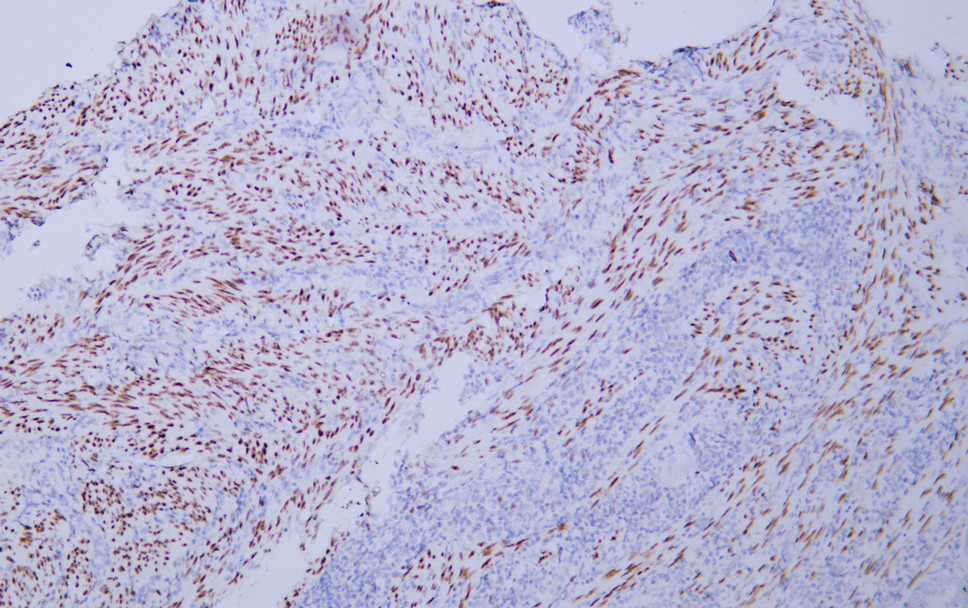WT1 Polyclonal Antibody
- Catalog No.:YN2274
- Applications:WB;ELISA
- Reactivity:Human;Rat;Mouse
- Target:
- Wilms' Tumor 1
- Fields:
- >>Transcriptional misregulation in cancer
- Gene Name:
- WT1
- Protein Name:
- Wilms tumor protein (WT33)
- Human Gene Id:
- 7490
- Human Swiss Prot No:
- P19544
- Mouse Swiss Prot No:
- P22561
- Rat Swiss Prot No:
- P49952
- Immunogen:
- Synthesized peptide derived from human protein . at AA range: 310-390
- Specificity:
- WT1 Polyclonal Antibody detects endogenous levels of protein.
- Formulation:
- Liquid in PBS containing 50% glycerol, and 0.02% sodium azide.
- Source:
- Polyclonal, Rabbit,IgG
- Dilution:
- WB 1:500-2000 ELISA 1:5000-20000
- Purification:
- The antibody was affinity-purified from rabbit antiserum by affinity-chromatography using epitope-specific immunogen.
- Concentration:
- 1 mg/ml
- Storage Stability:
- -15°C to -25°C/1 year(Do not lower than -25°C)
- Observed Band(KD):
- 49kD
- Background:
- This gene encodes a transcription factor that contains four zinc-finger motifs at the C-terminus and a proline/glutamine-rich DNA-binding domain at the N-terminus. It has an essential role in the normal development of the urogenital system, and it is mutated in a small subset of patients with Wilms tumor. This gene exhibits complex tissue-specific and polymorphic imprinting pattern, with biallelic, and monoallelic expression from the maternal and paternal alleles in different tissues. Multiple transcript variants have been described. In several variants, there is evidence for the use of a non-AUG (CUG) translation initiation codon upstream of, and in-frame with the first AUG. Authors of PMID:7926762 also provide evidence that WT1 mRNA undergoes RNA editing in human and rat, and that this process is tissue-restricted and developmentally regulated. [provided by RefSeq, Mar 2015],
- Function:
- disease:A chromosomal aberration involving WT1 may be a cause of desmoplastic small round cell tumor (DSRCT). Translocation t(11;22)(p13;q12) with EWSR1.,disease:Defects in WT1 are a cause of hypospadias. Hypospadias is a common malformation in which the urethra opens on the ventral side of the penis. It is considered a complex disorder with both genetic and environmental factors involved in the pathogenesis. Hypospadias can occur alone on an apparently multifactorial basis or as part of syndromes.,disease:Defects in WT1 are a cause of Meacham syndrome [MIM:608978]. Meacham syndrome is a rare sporadically occurring multiple malformation syndrome characterized by male pseudohermaphroditism with abnormal internal female genitalia comprising a uterus and double or septate vagina, complex congenital heart defect and diaphragmatic abnormalities.,disease:Defects in WT1 are a cause of Wilms tum
- Subcellular Location:
- Nucleus . Nucleus, nucleolus. Cytoplasm . Isoforms lacking the KTS motif have a diffuse nuclear location (PubMed:15520190). Shuttles between nucleus and cytoplasm. .; [Isoform 1]: Nucleus speckle .; [Isoform 4]: Nucleus, nucleoplasm .
- Expression:
- Expressed in the kidney and a subset of hematopoietic cells.
- June 19-2018
- WESTERN IMMUNOBLOTTING PROTOCOL
- June 19-2018
- IMMUNOHISTOCHEMISTRY-PARAFFIN PROTOCOL
- June 19-2018
- IMMUNOFLUORESCENCE PROTOCOL
- September 08-2020
- FLOW-CYTOMEYRT-PROTOCOL
- May 20-2022
- Cell-Based ELISA│解您多样本WB检测之困扰
- July 13-2018
- CELL-BASED-ELISA-PROTOCOL-FOR-ACETYL-PROTEIN
- July 13-2018
- CELL-BASED-ELISA-PROTOCOL-FOR-PHOSPHO-PROTEIN
- July 13-2018
- Antibody-FAQs



